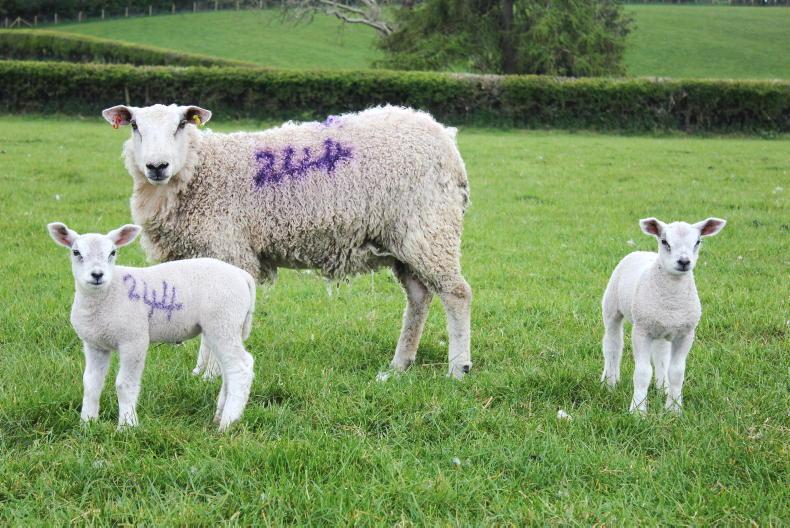As we approach the end of October, the question of tupping ewe lambs arises. Lambing ewe lambs can improve the financial viability of farms by reducing the number of replacements that need to be purchased.
Another important advantage of tupping ewe lambs is the faster genetic progress. However, good husbandry, nutrition and attention to detail must be adhered to. When selecting ewe lambs, it is important to only serve those that are a minimum of 60% of their expected mature bodyweight.
To put this into context, a mature Mule ewe will weigh on average 75kg, thus the target weight at tupping will be no less than 45kg to maximise conception rate and allow for foetal development; ideally, they should weigh above this threshold.
Ewe lambs will have a lower initial reproductive performance, due to multiple factors.
One of the main issues is the onset of puberty, which normally occurs when they are between seven and 10 months old, meaning not all lambs will cycle during the selected breeding window. Introduction of a teaser 14 days before fertile rams can help with the onset of puberty, and tightens the lambing period. In ewe lambs, we often see shorter, less intense cycles, with reduced ram seeking behaviour. Therefore, a smaller ram to ewe lamb tupping ratio (one ram to 25-30 ewe lambs) and keeping them in a smaller paddock is recommended.
Ram choice
The ram of choice for ewe lambs needs to be one which is easy lambing. Breeds such as Charollais and Beltex tend to fit the bill. Ideally, the use of Estimated Breeding Values (EBVs) should be employed, looking for traits such as lambing ease and a lower birth weight.
A ram which is easy lambing, with lower birthweights and good growth rates, should provide maximum lamb performance.
Finally, it is important to remember ewe lambs are still growing. They should be managed as a separate group, and require 20% more feed in early to mid-pregnancy and should maintain a daily liveweight gain of 250g/day, until six weeks post-tupping.
*Matthew Wright is a veterinary surgeon at Lisnafillan farm vets in Ballymena.
Read more
NI vet corner: Housing creates an environment for lice
Assess your rams against the five Ts
As we approach the end of October, the question of tupping ewe lambs arises. Lambing ewe lambs can improve the financial viability of farms by reducing the number of replacements that need to be purchased.
Another important advantage of tupping ewe lambs is the faster genetic progress. However, good husbandry, nutrition and attention to detail must be adhered to. When selecting ewe lambs, it is important to only serve those that are a minimum of 60% of their expected mature bodyweight.
To put this into context, a mature Mule ewe will weigh on average 75kg, thus the target weight at tupping will be no less than 45kg to maximise conception rate and allow for foetal development; ideally, they should weigh above this threshold.
Ewe lambs will have a lower initial reproductive performance, due to multiple factors.
One of the main issues is the onset of puberty, which normally occurs when they are between seven and 10 months old, meaning not all lambs will cycle during the selected breeding window. Introduction of a teaser 14 days before fertile rams can help with the onset of puberty, and tightens the lambing period. In ewe lambs, we often see shorter, less intense cycles, with reduced ram seeking behaviour. Therefore, a smaller ram to ewe lamb tupping ratio (one ram to 25-30 ewe lambs) and keeping them in a smaller paddock is recommended.
Ram choice
The ram of choice for ewe lambs needs to be one which is easy lambing. Breeds such as Charollais and Beltex tend to fit the bill. Ideally, the use of Estimated Breeding Values (EBVs) should be employed, looking for traits such as lambing ease and a lower birth weight.
A ram which is easy lambing, with lower birthweights and good growth rates, should provide maximum lamb performance.
Finally, it is important to remember ewe lambs are still growing. They should be managed as a separate group, and require 20% more feed in early to mid-pregnancy and should maintain a daily liveweight gain of 250g/day, until six weeks post-tupping.
*Matthew Wright is a veterinary surgeon at Lisnafillan farm vets in Ballymena.
Read more
NI vet corner: Housing creates an environment for lice
Assess your rams against the five Ts






 This is a subscriber-only article
This is a subscriber-only article










SHARING OPTIONS: